28th General Hospital Unit History
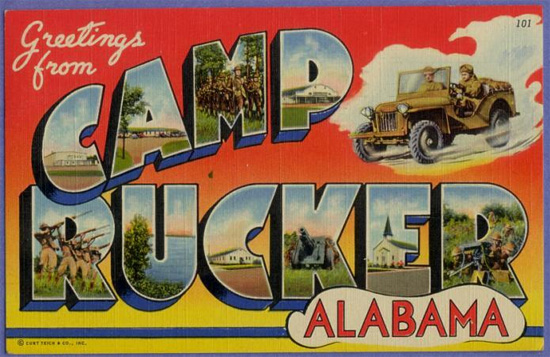
Vintage postcard illustrating Camp Rucker, Ozark, Alabama, Zone of Interior.
Introduction & Activation:
The 28th General Hospital was officially activated at Camp Rucker, Ozark, Alabama, Zone of Interior (Division Camp; total acreage 58,999; troop capacity 3,280 Officers and 39,461 Enlisted Men –ed) 15 June 1942. Camp Rucker was also home to Headquarters, 10th Hospital Center.
The Commanding Officer, Colonel Jaime J. Figueras, MC, O-10864, was appointed in April 1943, at which time, the unit was in training at Moore General Hospital, Swannanoa, North Carolina, Fourth Service Command. Coming to the 28th General Hospital he found the unit in poor order (it must be stated that this hospital was one of the non-affiliated medical units, which meant it had less opportunity to benefit from the necessary basic medical training and orientation dispensed to medical units at named General Hospitals or Universities in the ZI –ed). Many changes were therefore instituted in the organization and training schedules, so that by December 1943, the 28th was ready for foreign service.
Colonel J. J. Figueras was commissioned a 1st Lieutenant in the regular Army Medical Corps in 1921, and served in Panama, Nicaragua, as well as in many Army Posts throughout the continental United States. He graduated from the US Army Medical School in Washington D.C. (1926), attended The School of Tropical Medicine in San Juan, Puerto Rico (1931), and followed the advance course at the same institution (1938). He was promoted to Colonel 20 December 1943. Before being assigned to the 28th General Hospital, Colonel J. Figueras was Executive Officer of the 3d Medical Regiment, Medical Replacement Training Center, Camp Pickett, Virginia.
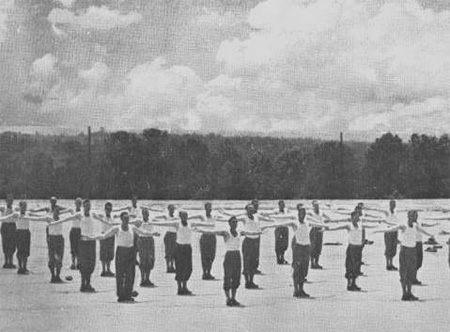
1942, Camp Rucker, Alabama, morning group calisthenics …
Between September 1939 and April 1944, Medical Department Theater of Operations units (i.e. scheduled for overseas service –ed) were activated and trained by the cadre system. Under this system, a new medical unit was built upon a nucleus of presumably trained personnel supplied by another unit. Depending on the unit being trained, the source of the cadre could be a Zone of Interior medical installation, such as a fixed General or Station Hospital, or another medical unit undergoing training in the ZI. The War Department Letter activating a new unit routinely specified the size of the cadre, the installation or unit that would supply the cadre, and the date at which the cadre would report for duty. The orders also included a schedule for the arrival of the Commanding Officer and other Officer and Enlisted personnel, and specified the sources of personnel other than cadre. The Surgeon General routinely supplied, other than cadre, Officers and Nurses, for all units (except those of the Army Air Forces). The Adjutant General supplied a given number of Medical/Surgical Technicians without requisition. Other fillers were requisitioned from The Adjutant General by the activating command as needed. Unit personnel were usually scheduled to arrive in several increments. The CO was normally expected to arrive alone on the day of activation, followed in a few days by the other Officers (MC, MAC, and ANC), and finally, by the unit’s Enlisted complement. In theory, the cadre system was designed to provide the Commanding Officer of a new unit with a nucleus of trained Officers and Enlisted Men capable of administering the unit and training other personnel. It was also assumed that all personnel would report to the unit within approximately a week after its activation. It was their task to put administrative and housekeeping affairs in order (this was difficult to meet, taking into account that in the early years of the war, medical units were plagued by a chronic lack of personnel and equipment. In part, these problems were the result of a nationwide shortage of the specialized men and materiel required by the Armed Forces reorganization of March 1942. Shortages of equipment were most severe during 1942 and the first half of 1943. In mid-1943, however, the situation began to improve, and by the end of the year, some units reported all of their equipment on hand –ed).
Unit commanders dissatisfied with their cadre or fillers usually attempted to improve their organizations by arranging transfers. This process of transferring and replacing undesirable personnel added to the inconvenience caused by the irregular arrival of fillers. Some organizations required many months to attain or approximate their T/O authorized strength and to become sufficiently stabilized to make meaningful unit training a possibility. At the time a General Hospital’s organization, for operation in a Communications Zone, was based on T/O 8-550 dated 1 April 1942 specifying an aggregate number of personnel consisting of 56 Officers – 1 Warrant Officer – 105 Nurses – and 500 Enlisted Men.
Training:
The original cadre of Enlisted Men reported to Camp Rucker, Alabama in June/July 1942. The Medical Officers joined gradually. Intensive training of the Officers in military discipline and administration began immediately. As more and more EM men joined the organization, their training was taken up by Non-Commissioned Officers, Medical Administrative Officers, and Medical Officers. Ward training was initially done at the Station Hospital, Camp Rucker.
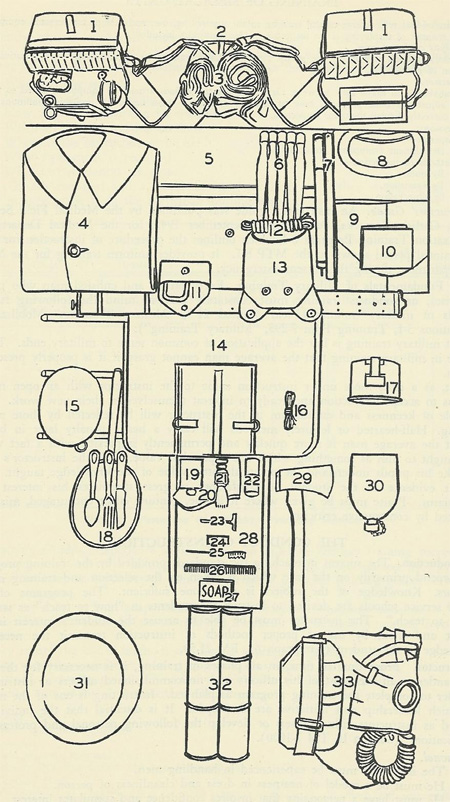
Display of Individual Medical Equipment for Dismounted Personnel, as foreseen in the Training Guide and the Military Medical Manual, 5th Edition, October 1942, The Military Service Publishing Co., Harrisburg, Pa., USA.
1. Canvas Medical Pouches; flaps underneath; EMT book and pencil pulled up
2. Medical Suspender; no space between Suspender and Shelter Half Tent
3. Two Cantle Ring Straps and 2 Litter Carrying Straps
4. Rubberized Raincoat; folded flush to edges of Shelter Half
5. Shelter Half Tent and Wool Blanket
6. Five Tent Pins; 1 inch from Tent Pole
7. One Pole; end Nail toward Inspecting Officer
8. Shirt, Olive Drab; flush to edges of Shelter Half
9. Drawers, Cotton; half over Shirt
10. Handkerchief, Cotton; to bottom edge and center of Drawers
11. Web Pistol Belt and First Aid Packet Pouch
12. Guy Line for Shelter Half Tent
13. Canteen Cover
14. Haversack; no space between it and Suspender flaps
15. Meat Can Cover; 1 inch from Meat Can Handle
16. Pair of Shoe Laces; neatly rolled
17. Canteen Cup; line up with outer edge of middle buckle of Haversack and edge of Canteen
18. Meat Can, Spoon, Fork, Knife, with U.S. up Handle 1 inch from edge of Haversack
19. Toothpowder or Toothpaste
20. Socks, Olive Drab; heels to left of Inspector bottom of Socks toward him, toes apart
21. Shaving Brush
22. Shaving Stick
23. Razor
24. Packet of 5 Razor Blades
25. Tooth Brush
26. Hair Comb
27. Soap Bar; with or without Box
28. Towel, Olive Drab; fold extends to edge of Haversack only
29. Intrenching Axe with Handle (Intrenching Axe Cover, not illustrated)
30. Canteen; line up with edge of Haversack and edge of Meat Can
31. Steel Helmet, Complete
32. Field Rations; Tins
33. Gas Mask and Carrier
In order to give the unit a better chance to achieve a certain efficiency, it was decided, in agreement with the staff at Moore General Hospital, to attach the 28th General to the organization for parallel training. It was considered that well-planned on-the-job training, coordinated with unit training offered the best guarantee for a sound and efficient training program. The Moore General Hospital (named after Brigadier General Samuel Preston Moore, Surgeon General, Confederate Army, 1813-1889 –ed) was officially designated Army General Hospital by War Department General Orders # 64, dated 24 November 1942, under command of Colonel Frank W. Wilson. Located at Swannanoa, North Carolina (near Asheville), it consisted of wooden cantonments with an authorized bed capacity of 2,605. The Hospital was ready to receive its first patient by 2 December 1942 and specialized in general medicine, tropical disease, general and orthopedic surgery, and psychiatry. It continued operating until 15 November 1946, after which the Hospital was transferred to the Veterans’ Administration.
It should be noted that a Medical Training Center to accommodate approximately 600 men was constructed in conjunction with Moore General Hospital. The project which had already been announced in the “Asheville Times” of 2 June 1942, explained that barracks, administration, buildings, and additional training facilities would be added to train personnel for the Medical Corps. New structures to expand the Hospital’s capacity were completed in October 1943 and included an additional 4 ward buildings, a Nurses’ quarters, a medical supply warehouse, a utility shop, a carpenter’s shop, and a shop for storage of lumber. The new structures were situated at widely separated spots on the big hospital grounds, filling in spaces left prior to Moore General Hospital’s expansion program.
Following its official opening in November of 1942, Moore General Hospital staged a first “Purple Heart” award ceremony for 77 overseas battle casualties received from the North African Theater on 3 December 1942.
Overseas Movement:
Following new orders, the organization was instructed to leave Moore General Hospital on 17 December 1943, and proceed to Camp Kilmer, its staging area for movement overseas. The main group left for Camp Kilmer at 1700 hours, 18 December. After reaching its destination processing was immediately started and a change of clothing took place (winter in the ETO –ed) followed by the distribution of gas masks accompanied by the necessary directions for their use. The first set of inoculations was effected at the staging area. The organization left Camp Kilmer at 2300 by train on 22 December, spending two very cold hours on the ferry enroute for the pier to reach the ship. The entire personnel of the 28th General Hospital, with the exception of the advance party, which had already left, boarded the British ex-liner RMS “Queen Mary” around 0430 hours in the early morning of 23 December. The ship left for the British Isles on Friday 24 December 1943.
Due to its speed and capacity, she sailed alone and not in convoy. The “Queen Mary” transported a total of 11,990 troops, including personnel of other units, such as the 118th Antiaircraft Artillery Gun (Mobile) Battalion – the 6th Naval Beach Battalion – the 5th Engineer Special Brigade – the 1st Infantry Division, and miscellaneous personnel. Anti-typhus shots were given on board Tuesday 28 December. The crossing proved uneventful although quite a few members of the unit’s personnel suffered from seasickness.
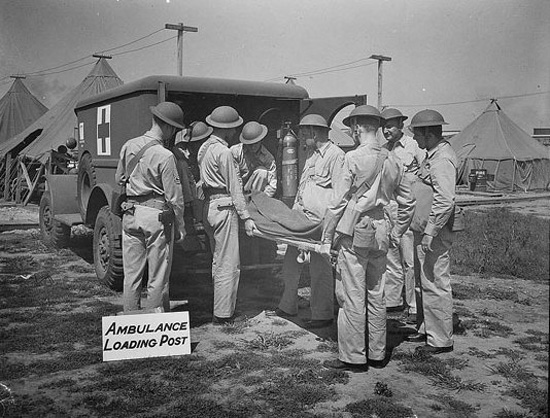
October 1942, scene illustrating medical training in the Zone of Interior with new WC-54 3/4-ton ambulance vehicle.
United Kingdom:
Setup Overseas
The “Queen Mary” docked at approximately 0900 in the morning of 29 December 1943 after reaching the Firth of Clyde. Debarkation took place at 0930 hours, Thursday, 30 December 1943, and after a short trip by tender, the personnel went on land and further proceeded by two troop trains to Tilshead, Wiltshire, Southern Base Section, arriving at its destination 31 December at 0400 hours, tired and hungry. Not a very pleasant way to visit Great Britain at all, as it was cold and raining. The unit’s first night was spent in this old British EMS camp sleeping on the cement floor with 2 blankets, in a muddy and dirty environment.
Complying with orders issued by Southern Base Section, United Kingdom Base, European Theater of Operations, US Army, the entire organization eventually moved to the Royal Victoria Hospital, Netley, Hampshire. Transfer began with an advance party leaving on Saturday, 8 January 1944, with movement being completed by 23 January 1944.
Stations in the United Kingdom – 28th General Hospital
Tilshead, Wiltshire – 31 December 1943 > 8 January 1944
Royal Victoria Hospital, Netley, Hampshire – 15 January 1944 > 15 February 1944 (in operation)
Trowbridge, Dorsetshire – 28 February 1944 > 6 April 1944
Kingston Lacy, Dorsetshire – 15 April 1944 > 25 July 1944 (in operation)
note: the Royal Victoria Hospital (the British Empire’s oldest military hospital) was returned at 1200 hours, 19 July 1945, with ceremony by the United States Army to the Royal Army Medical Corps. Lieutenant General Sir Alexander Hood, Director General, RAMC, received the key to the building from Brigadier General Charles B. Spruit, United Kingdom Base Surgeon. The last Army hospital to be located at the Royal Victoria Hospital annex (block E) was the 500-bed 121st Station Hospital, under command of Colonel George Thatcher, MC –ed).
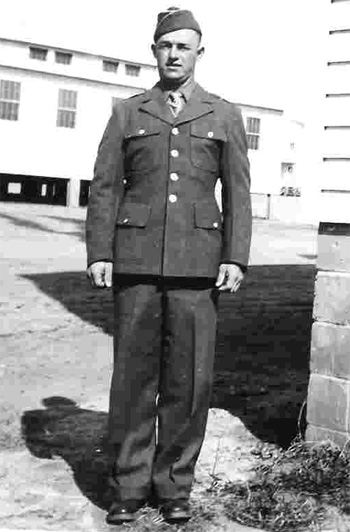
Photograph of Private Ernest B. Swett, ASN 31175968, at the end of his Basic Training received at Camp Rucker, Alabama. Photo taken around November 1942.
On 8 February 1944, and in accordance with orders received from SBS, ETOUSA, another movement to Trowbridge, Wiltshire, began, the entire unit being moved by 28 February. The 28th General remained at this location until 6 April 1944, when a new site was selected. New orders issued by Headquarters, Southern Base Section, United Kingdom Base, Ref. AG 323.3 (SG), dated 20 April 1944, and orders received from Headquarters ETOUSA, Ref. AG 323.3 OpMC, Opening of Hospitals, dated 17 April 1944, sent the hospital unit to a site located approximately 2½ miles west, northwest, of the railroad station at Wimborne, Dorsetshire. The initial work was done by the organization’s own personnel and consisted mainly of fitting out the plant, procuring supplies, setting up the messes, the offices, and building the necessary furniture and appliances. The job was enormous and rendered difficult by the scarcity of lumber required for shelves, bins, racks, etc.
The 28th General Hospital new location became Kingston Lacy, Wimborne, Dorsetshire, APO 597, where it officially opened to receive patients as of 0001 hours, 15 April 1944.
Personnel Build-Up
Since its arrival in the United Kingdom, the unit consisted of 57 Officers – 1 Warrant Officer – 105 Nurses – 2 Hospital Dietitians – 2 Physio-Therapists – 5 American Red Cross Workers – and 501 Enlisted Men. The Officer complement was broken down as follows: 39 Medical Corps, 5 Dental Corps, 2 Sanitary Corps, 8 Medical Administrative Corps, and 3 Quartermaster Corps. Above strength figures represent the situation as per 1 January 1944.
Housing Facilities
The organization’s first overseas location was Tilshead, Wiltshire, where it was put through a staging program. Housing facilities were provided in the form of Nissen huts, with bathing and toilet set up in separate hutments. Upon arrival the camp was found in a very dirty condition but an adequate state of cleanliness was soon obtained and maintained in spite of large amounts of mud (this was winter). Messing was handicapped by the difficulty in keeping mess halls and kitchen clean, and by the number of inadequate stoves. Facilities for classrooms were inadequate too. An indoctrination and orientation program was worked out to become familiar with conditions in wartime Britain. Guest speakers, including British and American Officers, and British civilians were invited.

Left: Aerial view of the Royal Victoria Hospital, Netley, Hampshire, England.Right: Front view of one of the wings of the Royal Victoria Hospital, Netley, Hampshire. The 28th General Hospital would call it home from 15 January 1944 through 15 February 1944.
The Royal Victoria Hospital provided luxurious grounds, although the physical structures were old and dirty for the most part. The Officers were housed in the current Officers Mess, while the Nurses were quartered in the space formerly used by the British Nursing Sisters. The Enlisted personnel were set up in unused wards in the main hospital building. For the most part, the incoming patients were British, except those received from the command (one block and the psychiatric wing remained in British hands –ed).
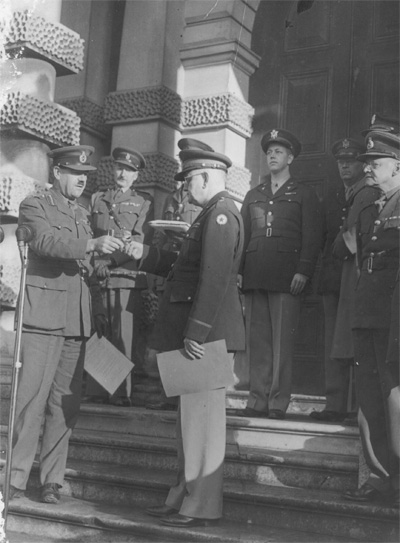
15 January 1944; official turnover ceremony of the Royal Victoria Hospital to the 28th General Hospital. Colonel Jaime J. Figueras, MC, O-10864, CO – 28th General Hospital stands in front, while Major Walter H. Gerwig, Jr., MC, O-334762, XO – 28th General Hospital stands at the top of the stairs, in the middle.
Following preliminary discussions with British RAMC Officers, it was agreed that a first group of 28th personnel comprising 10 Officers, and 70 Enlisted Men would arrive and that preparations for takeover of the hospital premises would start 9 January. Upon arrival the hospital was still staffed by members of the Royal Army Medical Corps, under command of Colonel Kidd, RAMC. A second group of personnel including 10 Officers, 40 Nurses, and 150 EM arrived three days later. The place was placed under American command, after arrival of the advance party. The third and last group of personnel was only to arrive by 23 January. Official opening (with an elaborate ceremony) took place on 15 January 1944. Upon taking over operation of the Royal Victoria Hospital, the organization inherited 350 patients, classified as follows: 19 British Officers, 329 British Enlisted Men, 2 Italian PWs. Hospital messing only passed into American hands on 20 January. Contact with the British was satisfactory in all respects. Unfortunately, the place was dirty, and for the most part the equipment was inadequate and obsolete. Another problem was that all equipment was listed under British RAMC terminology, unfamiliar to the new medical staff. The continued presence of British patients made keeping records difficult, as dual ones had to be prepared for both the British and US authorities. As the stay was only to be temporary, it was difficult to systematize activities. During most of January 1944, with the Commanding Officer, Colonel Jaime J. Figueras, MC, O-10864, often absent, Major Walter H. Gerwig, Jr., MC, O-334762 was in fact acting Commander of the 28th General Hospital.
On 27 February 1944, the Royal Victoria Hospital was turned over to the command of the United States Navy, following verbal orders issued by Headquarters, Southern Base Section, United Kingdom Base, ETOUSA. US naval Officers appeared at the 28th General several weeks before the command was given to their service. Upon releasing the Hospital to the US Navy, the patient load was 12 British Officers, 272 British Enlisted Men, 1 US Navy Officer, 2 US Navy Nurses, 7 US Navy Enlisted Men, and 10 Italian PWs. The Outpatient Department handled 1,125 British and 174 American patients, for a total of 1,661 treatments.
It must be noted that the Royal Victoria Hospital, APO 229, was used by other US Army Hospitals later in the war. In March 1945 block “E” was briefly occupied by the 110th Station Hospital; on 14 March 1945 the 232d Station Hospital took over, followed by the 121st Station Hospital on 12 June 1945; and the 305th Station Hospital which eventually started operating block “E” as from 30 August 1945 …
In Trowbridge, Wiltshire, the entire staff and personnel were billeted in private homes starting 22 February 1944 (4 individuals per home). No home contained male and female personnel, and in no place were Officers and EM set up together. The existing facilities were excellent, yet, a few of the Enlisted Men had no electricity in their rooms, and running water and bathing were located apart. The eventual establishment of central bathing for all Enlisted personnel compensated for this. Messing took place in an old flour mill, which had three floors; the first of which was used for cooking, the second for the Officers messing, and the third for the administrative offices. The lack of adequate classrooms and teaching materials made training difficult, moreover it was hard to maintain groups as the personnel was scattered in different homes. The lack of actual medical work made the Nurses and the Medical Officers a bit uneasy at times.
While in Trowbridge, there existed a close relationship with the British, this time the civilians in whose homes the personnel were billeted, and quite some socializing took place. On 14 March 1944 a dance party was given in honor of the British hosts. It was well attended and the people of Trowbridge were delighted with the American hospitality, including the offered food and drinks.

Individual pass issued by Headquarters 28th General Hospital, to Technician 5th Grade Ernest B. Swett, ASN 31175968. At the time the organization’s staff and personnel were billeted in private homes, for a period lasting from 28 February 1944 through 6 April 1944.
By 8 March 1944, an advance party had already moved to Kingston Lacy to inspect the new site. The new location at Kingston Lacy was of the cantonment type. Buildings and appurtenances had been planned and set up for the operation of a Station Hospital, which meant that the premises were therefore small in every respect for operating a General Hospital. All necessary facilities for good medical practice and housing were nevertheless provided. The ground around the buildings was rolling, well wooded, and provided much scenic splendor. After arrival, the 28th was faced with the usual problems of a new unit. Supplies had to be requisitioned and obtained, buildings had to be completed, before the Hospital could begin to function as a medical installation. Authorized bed capacity was 834, split over 28 wards. An additional Physio-Therapy ward was added, and there were 15 separate ward tents with an additional 330 beds, in case of emergency. Storage space for medical and quartermaster supplies had to be augmented with 4 ward tents and 3 pyramidal tents. Although construction seemed adequate, the installation was overcrowded. All buildings on the site were serviced by adequate personnel assigned as civilian maintenance by the British authorities. Field Rations A (corresponding to garrison rations –ed) and mess food were sent by train and picked up at railhead # 15.
The unit’s personnel balance only arrived at Kingston Lacy on 6 April, with beginning of the operation planned for 15 April 1944.
Functions
The organization functioned as a General Hospital from its opening 15 April 1944 through 2 June 1944.
As from 1 May 1944, the term “Transit Hospital” was used to designate Station or General Hospitals which initially received the greater portion of casualties returning to the United Kingdom. As such, the fixed 28th General Hospital allocated to the Southern Base Section, United Kingdom Base, ETOUSA, by the Chief Surgeon was designated “Transit” Hospital. The organization therefore acted as a “Transit” Hospital from 3 June 1944 until 23 June 1944.
Above designation of “Transit” Hospital was officially removed by Letter SG 323.3 x 322, issued by Headquarters, Southern Base Section, Communications Zone, ETOUSA, APO 519, dated 27 June 1944, whereby the unit was to resume normal functions as a General Hospital.
Starting from 24 June 1944 until 15 July 1944, the 28th functioned again as a regular General Hospital.
Note: the 208th Quartermaster Laundry Platoon (type B) was attached to the organization on 27 May 1944 for rations and quarters.

WC-54 3/4-ton Dodge 4 x 4 Ambulances stationed at one of the EMS medical installations (Admitting Office) somewhere in southern England.
D-Day & Post D-Day Period
In view of the forthcoming Operation “Overlord”, orders were received assigning the 28th General Hospital to Forward Echelon, Headquarters, Communications Zone, ETOUSA, Authority: Commanding General ETOUSA, dated 22 May 1944, Ref. AG 322 OpCG, Troop Assignment, and Letter Order putting the 28th General Hospital on Alert, Forward Echelon, Headquarters, Communications Zone, ETOUSA, dated 30 May 1944, Ref. Alert Order, Authority: Commander ComZ.
40 Medical Officers and 69 Enlisted Men were attached to the 28th General Hospital just before D-Day to be on call for any special duty. They left the Post on several occasions under orders.
As of 15 July 1944, the current strength of the 28th General Hospital consisted of 29 Medical Corps Officers, 5 Dental Corps Officers, 2 Sanitary Corps Officers, 2 Quartermaster Corps Officers, 2 Corps of Chaplains Officers, 8 Medical Administrative Corps Officers, 102 Nurses, 1 Warrant Officer, 2 Hospital Dietitians, 2 Physio-Therapists, and 4 American Red Cross Workers. The total of Enlisted personnel reached 497.
It should be added that the 28th had a Neuro-Surgical Team consisting of 2 Surgeons, 1 Anesthetist, 1 Nurse, and 2 Enlisted Men; and an Orthopedic Team with 1 Officer, 1 Nurse, and 2 Enlisted Technicians. Both Teams were on DS with other units.
On 25 July 1944, the Hospital Plant at Kingston Lacy, APO 519A, was officially turned over to the 106th General Hospital (coming from Fort McClellan, Alabama, IRTC, and commanded by Lt. Colonel Orval J. Miller –ed), which was to remain at the site until it closed at 2400 hours, 6 July 1945, for operations.
Medical Operations
From 15 April 1944 through 3 June 1944, the unit handled 907 admissions and 568 dispositions. There were 2 deaths, both caused by bicycle accidents. Outpatients treated during that period totaled 2,308.
From 3 June 1944 through 23 June 1944, the 28th was the FIRST General Hospital in ComZ, ETOUSA, to receive battle casualties from the invading forces in France! The first arrived on 7 June, and as the census gradually increased, the Medical Officers worked 12-hour shifts and the Nurses 8-hour shifts, with only approximately 7 hours of rest between each shift. Many Enlisted Men, after working long hours in their respective fields, volunteered their services as extra litter bearers. The entire personnel, however, was organized into adequate shifts for day and night emergencies.
From 7 June 1944 (arrival of first battle casualties –ed) through 23 June 1944 a total of 464 operations were performed (of these 113 minor surgical operations were carried out in a separate OR set up for minor injuries –ed). During the same period, 209 pints of plasma were consumed and 228 whole blood transfusions were given. The personnel of the 28th Gen Hosp contributed 128 pints –ed). About 10,000,000 units of penicillin were used per day throughout the period. The new drug was administered by two teams of Nurses (consisting of 2 Nurses each –ed), who toured the Hospital grounds arriving in each ward every 4 hours and giving the new drug according to a list posted by the responsible Ward Officer.
During the period 3 June through 23 June 1944, there were 1,900 admissions and 1,891 dispositions, and 9 deaths. Six (6) of the death were combat losses, the others were either accident and disease cases. The number of outpatients treated by the organization reached 373.
Many mistakes were made, but the 28th learned many valuable lessons by experience. During this period an attempt was made to x-ray each patient on admission. This was a failure, because it resulted in such a congestion (in the X-Ray department), causing delay and needless extra work. It was rectified by assigning additional personnel to the Admission and Disposition office charged with triage duty.
To make sure that no patient was evacuated before receiving adequate treatment, the CO directed the use of yellow-colored tags, which were hung on each patient’s bed/cot immediately on arrival. The tags signified that the patient was non-evacuable! The system proved successful as it eliminated errors in selecting patients for evacuation. The mass evacuation of patients was carried out smoothly and not only boosted the morale of the patients but also that one of the unit.
From 23 June 1944 (after which date, the unit reverted to the status of General Hospital -ed) through 9 July 1944, there were 721 admissions, 254 dispositions, and 2 deaths. One (1) death was a battle casualty, the other resulted from a training incident, incurred at the soldier’s place of duty. During above period, 304 operations were performed, 119,700,000 units of penicillin were administered, 183 wounded cases returned to duty, 9 patients were evacuated by air to the Zone of Interior, and 58 evacuated to other hospitals in the UK or on the Continent for further specialized treatment. The 28th Outpatient department treated a total of 369 patients during this time. The census on 10 July 1944 was 767 patients.
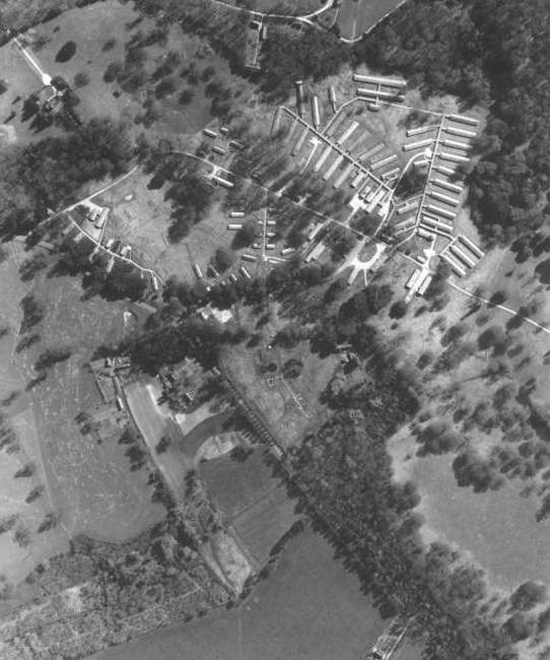
Aerial view of Kingston Lacy grounds, Dorsetshire, England, last station of the 28th General Hospital in the United Kingdom. The unit remained at Kingston Lacy from 15 April 1944 through 25 July 1944.
Following the receipt of new Alert Orders, the unit was instructed to prepare for movement to an overseas destination.
Between 22 July 1944 and 10 August 1944, the organization camped at Bishops Court, near Exeter, in Devonshire.
Additional Data
So far 165 patients received the “Purple Heart” after recommendation of their Officers. More PH medals were requisitioned for other battle casualties being treated at the 28th General Hospital. The ceremony of bestowal was always carried out in a simple but impressive way by the Hospital’s Commanding Officer, accompanied by the Executive Officer and the Detachment of Patients Commander, while all the Commissioned and Noncommissioned personnel of the respective ward stood at attention.
Throughout the past period, the Plans & Training Officer, Major David W. McCreight, MC, O-420148, whenever the opportunity presented itself, supervised the following: a review of basic training; lectures and practical demonstrations in repelling incendiary and gas attacks; a four-hour demonstration in gas decontamination apparatus and operation by the 18th District Gas Training Team; the use of the Gas Chest; instruction on advanced subjects such as blood plasma, whole blood, and dry runs of massed evacuation by patients, including evacuation by train and motor vehicle. Monthly inspections as required by Southern Base Section Headquarters were accomplished by inspectors from the above organization and the 18th District Headquarters. VIP inspections took place once in a while, including at various times, distinguished Officers such as Lieutenant General John C. H. Lee, Brigadier General Charles O. Thrasher, and Major General Paul R. Hawley. The high-ranking Officers seemed to be satisfied with the results of their inspection tour. Another ‘special’ guest was Her Majesty, the Queen Mother (Queen Mary –ed)
For recreational purposes, an Officers’ Club was formally organized on 3 May 1944. This was followed on 3 June 1944 by a new Enlisted Men’s Recreational Building, properly fitted with a twenty-five foot bar, a piano, a radio, suitable furniture and rooms for study, reading, or letter writing. To promote sports and physical conditioning, the Special Service Officer set up 13 softball teams and 1 baseball team which often played against teams of other United States Army units.
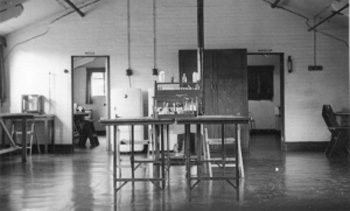
Partial inside view of one of the buildings at Kingston Lacy, Dorsetshire, England.
France:
The last phase of the unit’s stay at its staging area was full of restrictions, movement in and out the bivouac area was forbidden, all passes and leaves were revoked, and no mail could be received or sent out. Further instructions were received ordering the 28th to move in 3 different groups. Motor convoys consisting of 2½-ton trucks and British-made buses were to move for Eastleigh, via Exeter, England. Leaving its bivouac at Bishops Court, in Devonshire, on 10 and 11 August 1944, the 28th General Hospital entrucked for the marshalling yards near Southampton in order to prepare for another overseas movement. A final processing took place, followed by more instructions and issue of French currency. The entire group finally left by motor convoy at 1100, 12 August 1944, and after reaching the Southampton docks marched another 5 miles to board the waiting ship.
The organization left the United Kingdom on 13 August, passing the port of Cherbourg, early the next day, dropping anchor off Utah Beach. An LST then picked up the men around 1830 hours and after moving closer to shore, debarked them on Utah Beach, France, 16 August 1944. The group then marched to Assembly Area “B”. After assembly and preparation of the necessary transportation, a 25-vehicle convoy carried the personnel to a bivouac site in the vicinity of Carentan the following day, near the 62d General Hospital, Hospital Plant # 4315, where they would remain from 18 August 1944 through 23 September 1944. Fortunately the move took place in dry weather.
Following instructions from ADSEC Headquarters, 12 surgical teams were set up to accompany and medically support First United States Army Divisions. While at the bivouac, messing remained basic with food mainly consisting of K, C, and D rations. The organization tried to make the best of it, by pitching individual tents, dugging latrines, and making overall conditions liveable. With the continuous advance of the Allied Armies, convoys with men, guns, ammo, and supplies crowded the roads going up and down; while the first ones went up, the others came back with casualties and enemy prisoners. Many civilians were returning to their shattered homes with their little carts of belongings. Due to the heavy rains, the camp became a sea of mud and understandingly spirits were low. It was nearly impossible to dry clothes, going to the latrines proved hazardous, there was no electricity, and bathing had to be done in a helmet with cold rain water, occasionally some hot food was brought in. It just continued to rain, and in the end everyone was soaking wet. The hospital’s supplies were only landed on Utah Beach 26 August 1944 and the first large tents finally reached the 28th on 1 September. Nevertheless, another 2 general surgical teams and 3 shock teams were organized and sent up to about 40 miles from Paris. It became difficult to follow the fast moving Armies, and medical installations seemed to be continuously setting up or on the move, gasoline was limited, and vehicles became stranded in forward areas for lack of maintenance. Following orders issued by the Communications Zone’s Advance Section in Paris mid-September 1944, the 28th General was ordered to move to Clichy, a suburb 9½ miles from central Paris, and set up at the Hôpital Beaujon, where the 108th General Hospital, Hospital Plant # 4314, was currently operating. Orders were however changed 18 September, with the organization now expected to move to Le Vésinet (another wealthy suburb some 30 miles from Paris, with a French hospital built by Eugène Laval in 1859 –ed) for staging (although these orders too were cancelled on 20 September 1944). Two (2) days later new orders were received directing the hospital to Liège, Belgium!
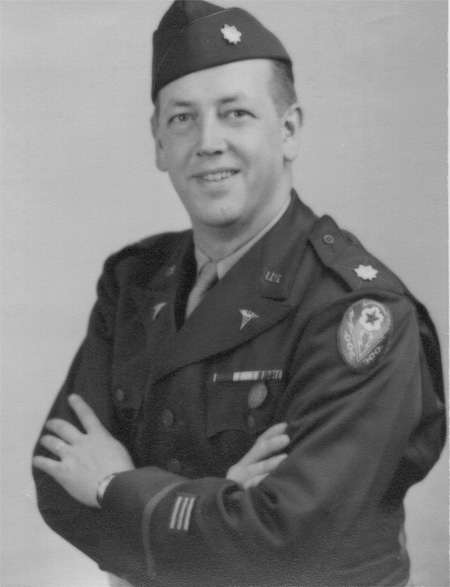
Portrait of Major Walter H. Gerwig, Jr., MC, O-334762, Executive Officer, 28th General Hospital.
Belgium:
Following the rapid advance of Allied Armies to the east, and in order to strengthen ground evacuation, SHAEF authorized General Hospitals to cross the Seine River and by mid September of 1944 had already 2 units bivouacking near Reims and 3 more in Paris, France, ready for further assignment. General Hospitals already established in northern France were instructed to deploy further and set up positions close behind First and Third United States Armies. Consequently, in order to provide more beds to First US Army, the 15th General Hospital, Hospital Plant # 4345, opened in Liège, Belgium, in a former Belgian military hospital on 21 September, while the 28th General Hospital, Hospital Plant # 4339, arriving in the city 26 September, went into operation on 7 October 1944. The organization supporting Hospital Plant # 4339 was to occupy the Fort de la Chartreuse buildings (part of the Belgian Army fortification line running along the Meuse River and Liège –ed) and now came under control of the Channel Base Section.
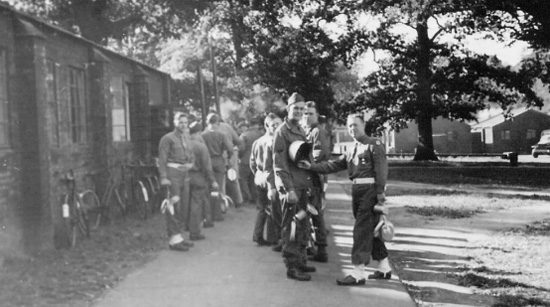
Hospital personnel preparing for a ‘formal’ parade or ceremony at Kingston Lacy, Dorsetshire, England. This could be in view of a Purple Heart award, a Promotion ceremony, or another festive activity …
On 25 September 1944 the advance party left for Liège, Belgium, via Paris, being stopped in Namur, Belgium, because of a German air raid. Hospital Train No. 16 was to leave the same day with the remainder of the unit. The advance group resumed its route the following day arriving at the Fort de la Chartreuse 26 September. Soon overcrowded by a large influx of patients, a Platoon pertaining to the 50th Field Hospital was brought in to help on 4 October. They immediately set up an operating room and an x-ray department in tents outside the buildings, as more wounded were expected the coming days. Although the Engineer detachment had not started connecting the buildings, 436 beds were up and ready to receive the patients. The Surgical Service team consisted of 19 Officers and 142 Enlisted Men. At 2000, 7 October, the service had admitted over 500 patients who were all over the place, in beds, on cots, on the floor, in the halls, just everywhere. All came directly from the frontlines, and treatment remained at first chaotic with no latrines, no hot food, no hot water, no drinking water, no elevators, little medicine, and no supplies. The situation slowly improved after arrival of some equipment, and evacuation of the first 304 patients by hospital train bound for the west. Admissions however continued with the census increasing up to 550 patients the next day. More hospital beds were filled with some patients now going to the teams operating under tentage under Captain John M. Kibler, Medical Corps. Another group of 414 patients was evacuated early in the morning of 9 October. Air raids were more dense now, and German planes often made reconnaissance flights over the city announcing future bombing by artillery or aircraft. By 11 October the medical buildings were still not complete so a number of patients had to remain in the tents. Seventy-five (75) German PWs, came in, some of which were quite sick. Colonel Charles H. Beasley, ADSEC Surgeon, visited the hospital building on 25 October 1944, followed by an inspection from the organization’s own Commanding Officer on 28 October. The Platoon on TD from the 50th Field Hospital was released and moved on 22 October and the tents taken over by the unit’s own OR teams. Between 7 and 31 October a total of 3,858 patients were admitted (3,069 surgical & 789 medical cases) and during November 1944 total admissions numbered 5,504 (4,382 surgical & 1,122 medical cases). In December 1944 the 28th General reported only 2 deaths among over 4,000 surgical patients it received from the First and Ninth United States Armies, and only 1 man with gas gangrene, who recovered. Evacuation took place by hospital trains (314 patients were evacuated 11 November 1944). A new Chief Nurse joined 9 November 1944, while 2d Lieutenant Nell L. Moore, Hospital Dietitian, and 2d Lieutenant Mary J. Wullenwaber, Physical Therapist left on 1 December 1944. Among the number of battle casualties admitted mid-November were a lot of trench foot cases which were on the increase; a new load of German patients were brought in for treatment as well. The cluster of General Hospitals stationed in and around Liège were put under the jurisdiction of the 818th Hospital Centerwhich had become operational 14 December 1944.
Some men watched the American antiaircraft fire from the roof of the building during the air raids, which looked almost like the Fourth of July! Aerial bombing and strafing were not the only hazard, starting 20 November 1944 and 16 September 1944 respectively, Liège became a target for German V-1 and V-2 flying bombs and rockets (Vergeltungswaffe 1 & 2 –ed) with 86 V-1 bombs and 27 V-2 rockets being launched against the city before the close of 1944 (many directed against other targets in Belgium and France also flew over the city –ed). Fortunately some misfired, others flew off course, some exploded in mid air, and a few even failed to explode at all. Anyway, such impacts and explosions not only caused enormous destruction and death but played havoc with the medical personnel and the patients. Friendly and enemy aircraft flew constantly overhead and the threat of buzz-bombs and rockets suddenly coming down over the city of Liège (important supply center –ed), accompanied by a rain of friendly flak was a terrible experience to all.
The Germans started V-2 rocket operations early September 1944 targeting England as well as some of the cities recently liberated by the Allied Forces. Initial firings began on 6 September 1944 with London and Paris as first targets. At first some batteries were set up in the Belgian Ardennes, St. Vith and Houffalize, and in Wassenaar, Holland, but these were eventually moved to other sites in Holland (Walcheren) and Germany (Euskirchen). Cities targeted on the continent now included Paris, Lille, Liège, Mons, Tourcoing, Arras, Cambrai, Hasselt, Maastricht, and Charleroi. Notwithstanding Operation “Market Garden” and Allied bombings, operations continued with batteries moving to new sites in Holland and Germany. Although V-2 launches often suffered from fuel shortages, misfires, and technical failures. they continued well into 1945, still targeting southern England and the port of Antwerp, Belgium. Failing supplies and the overall Allied advance started to affect operations with the final launches against Kent, England, and Antwerp, Belgium, taking place respectively on 27 and 28 March 1945. At the end of the V-2 campaign, approximately 3,172 rockets had been launched –ed.
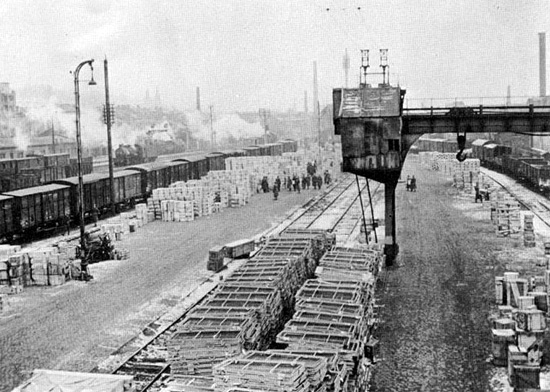
General view of Medical Depot M-409 at Liège, Belgium. The illustration shows railroad spurs and track sidings adjacent to a warehouse.
The early afternoon of 20 November 1944, a first V-1 hit the Gare des Guillemins (major railhead center –ed) area and this started the regular buzz-bomb offensive against Liège. There was considerable damage and troops now began sleeping in basements and shelters seeking more protection. On 22 November several V-1s hit the city and in one tragic incident, one ricocheted off the top of a trolley and hit the upper floors of a nearby girls’ school killing 36 and injuring many more. On 24 November another V-1 buzz-bomb hit the 15th General Hospital (it therefore moved to the Citadelle in Liège –ed) killing 12 and injuring 15 members of its personnel.
Medical units were however to be tested in withdrawal, encirclement, and hastily improvised counterattack during the surprise German counteroffensive in the Belgian Ardennes (Battle of the Bulge –ed) codenamed “Wacht am Rhein” which struck the Allied Armies on 16 December 1944. At the time rumors abounded about the enemy capturing towns and depots, shooting disarmed American prisoners, and of paratroops being dropped behind the Allied lines. Air raids were still going on, sirens, planes, buzz-bombs, rockets, antiaircraft artillery, made life almost unbearable and kept people jittery with tension and fear. Meetings were held to judge the situation in order to decide whether it was time to evacuate and retreat… by Christmas Day however the German “Blitzkrieg” in the Ardennes was running out of gas, and once the weather improved Allied Air Forces came into action.
Coinciding with the start of the German counter-offensive in the Belgian Ardennes, a second series of V-1s and V-2s were launched against the city of Liège, and in addition the Luftwaffe made their appearance once more. On 17 December 1944, a V-1 hit the QMC Fuel Depot in Liège setting 400,000 gallons of precious fuel on fire; on 21 December, another one struck the Gare des Guillemins demolishing and damaging 15 freight cars and setting fire to another 6. On 26 December 1944, the day after Christmas, the 28th General Hospital took a hit from a V-1, and ironically enough the only person killed was a German PW (when the hospital was hit by a buzz-bomb, causing considerable damage and many casualties, Lt. Colonel Walter H. Gerwig, Jr., MC, O-334762 (then Major), although wounded refused first aid so as to administer to the many casualties, he was awarded the Purple Heart for wounds sustained in battle –ed). Other Officers who were wounded included Major Heyward J. Blackmon, MC, O-271025; Captain Meyer Bloom, MC, O-530600; Captain William H. Moore, Jr., MAC, O-509494; Captain Bruce I. Ryder, MC, O-511047,of whom some were pretty badly hurt (Purple Hearts were officially awarded with General Orders No. 15, issued by Headquarters, 28th General Hospital, Advance Section, Communications Zone, US Army, dated 20 February 1945, to 5 Officers and 12 Enlisted personnel –ed). Other sources also include Major Jabez F. Jackson, MC, O-38402, as well as 1st Lieutenant Evelyn G. Prescott, ANC, N-726705. First Lieutenant Theodore Monolidis, MAC, O-2046759, Assistant Registrar at the time, was recommended for award of the Bronze Star Medal on 13 June 1945, signed by Colonel Jaime J. Figueras, CO, 28th General Hospital and approved by Headquarters & Headquarters Detachment, 818th Hospital Center, 14 June 1945, signed by Colonel Robert B. Hill, Commanding Officer. Although initially approved the recommendation for the BSM award was replaced by a Certificate of Merit, dated 13 August 1945 approved by Brigadier General E. F. Koenig, Chanor Base Section, Commanding, deemed a more appropriate award.
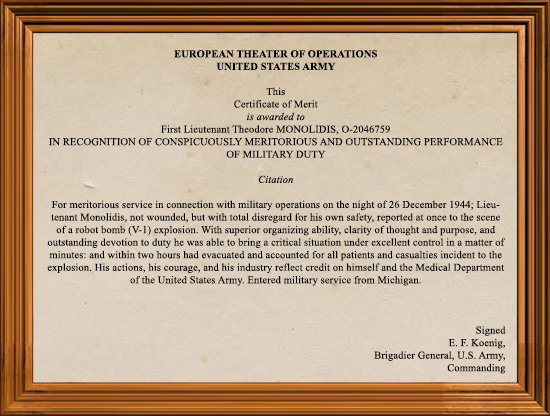
One more V-1 hit the railyards killing 8 troops and injuring 20. Flying bombs, rockets, and Luftwaffe bombs and bullets continued to rain down on the city into the new year. 2 January 1945, a V-2 hit a hospital train demolishing 3 ward cars, damaging another 5, and shattering all the glass in another train including any nearby buildings. On 8 January, a V-1 bomb struck the 76th General Hospital (Hospital Plant # 4341, located on the Champs de Manoeuvres –ed) killing 24 patients and personnel and injuring 20 more, as well as severely damaging buildings and equipment. Another buzz-bomb struck the Fort de la Chartreuse area on 9 January 1945. By the end of the campaign against Liège, 92 soldiers had been killed and 336 wounded; there were 1,158 civilian casualties, and over 80,000 houses damaged or destroyed during this concentrated attack. The V-weapons severely affected daily life, operations in ports and railroads, as well as highway traffic, taking their daily toll of human lives.
On 11 February 1945 the 28th received a large number of admissions, resulting from the severe fighting during the First United States Army advance in the area around Cologne, Bonn, Remagen and Koblenz. The first emaciated and starving RAMPs (recovered Allied PWs –ed) were received 6 April 1945, and more were expected from the recently-liberated German Prisoner of War camps. The same month, the news that FDR (1882-1945) had died on 12 April was received with consternation. A special ceremony was held on 13 April 1945 to honor the President and flags were ordered to remain half-mast for the remainder of the 30-day official mourning period. With the large influx of Recovered Allied Military Personnel, the 28th General Hospital became a temporary RAMP Hospital on 9 May, providing initial medical treatment, and preparing them for evacuation by air. The same day services were held for V-E Day, with a large parade and review on 11 May 1945. During May, amended plans for Redeployment and Readjustment (initially introduced 15 September 1944, revised 15 February 1945, and amended 5 March 1945 –ed) in the European Theater of Operations were issued prescribing the basic policies and procedures for the guidance and necessary action of the Commanders of major commands. Instructions followed based on the simple principle of returning those troops which had fought longest and hardest home for discharge! “POM-RED” or Preparation for Oversea Movement-Redeployment, SOP (Standard Operating Procedure) No. 61, comprising detailed instructions for unit CO whose units were scheduled for Redeployment were distributed. The talk of the day among staff and personnel focused about how to reach the initial criteria for going home, learning about individual ASR scores (Point System), and checking the unit’s category. (fortunately, Japan’s surrender altered redeployment activities in USFET, with the necessary action directed to intercept movement of materiel and men to the Pacific area –ed).
(the “Basic Plan for Redeployment and Readjustment” dated May 1945, considered 4 different categories of units: Category I – those units to be retained as occupation troops. Category II – those units to be transferred to an active Theater, either directly or indirectly through the Zone of Interior, or transferred to the United States to be placed in strategic service. Category III – those units to be converted or reorganized and, upon completion thereof, to fall under Category I or II. Category IV – those units to be demobilized –ed).
Meanwhile due to reduced activities, passes, furloughs, and leaves became more plentiful….
By end of May 1945, there was very little work, the hospital only had a census of 400 and very few admissions. On 18 June 1945, the organization was alerted and it was learned that the 28th would go back to France. Meanwhile it had been confirmed that the unit would be awarded another miniature bronze star for the “Ardennes-Alsace” Campaign. The following two days patients were prepared for evacuation and by 21 June only 13 remained in the building. Equipment was packed, tents were dried and folded, and everyone was making every effort to speed up packing in order to be ready to leave as soon as the orders to move would come in.

Picture of Major Walter H. Gerwig, Jr. and Surgical Staff taken while serving in England. To his left is his close friend, Major John M. Kibler, MC, O-1683896 (Chief Urology Section).
A few Officers left 25 June 1945 for France to reconnoiter the new site and report to Liège, traveling by ¼-ton truck, and stopping for quarters and rations on the way at the 298th General Hospital (Alleur), the 56th General Hospital (Caserne Fonck), and the 130th General Hospital (Ciney), enroute for Reims and Sissonne, France.
France:
The organization received alert orders on 25 June 1945 with instructions to prepare for departure involving another change of station. Following the evacuation of all remaining patients, which was completed by 18 June, an advance party of Officers left Fort de la Chartreuse the same day (25 June 1945) for France. Following orders for movement to a new station, the 28th General Hospital left the city of Liège, Belgium, on 5 July 1945, for an existing hospital site at Sissonne, France.
As per Letter AG 323.3 OpMC, Headquarters, United States Forces, European Theater (USFET), (Rear), APO 887, dated 9 July 1945, the 1,000-bed 28th General Hospital officially opened to receive patients as of 0001 hours, 13 July 1945. The new location previously occupied by the 241st General Hospital, Hospital Plant # 4361, was designated Site # 1, Camp d’Orléans, Sissonne, France, APO 513. The organization officially closed for operations as of 2400 hours, 26 September 1945 (USFET replaced ETOUSA 1 July 1945 –ed).
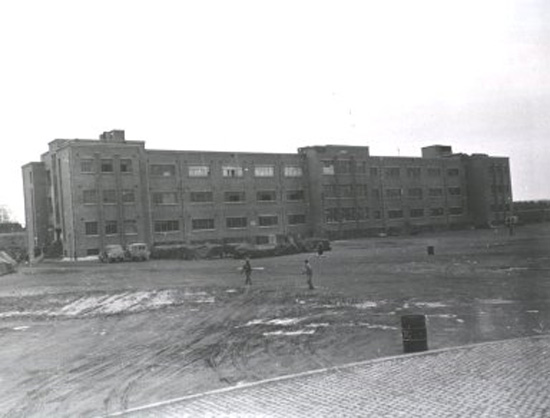
General view of the main building housing the 28th General Hospital, at the Fort de la Chartreuse, Liège, Belgium. The complex of existing buildings was taken over by the organization and in use from 26 September 1944 through 5 July 1945. While stationed there, the Hospital suffered two hits by V-1 buzz-bombs
Postwar Activities:
The 28th General Hospital was re-activated at 0010 hours, 1 December 1946, under T/O & E 8-550, dated 3 July 1944, and amended, at Osaka, Honshu, Japan, APO 660, under command of Lt. Colonel Michael L. Sheppeck, MC, occupying the buildings formerly operated by the 13th General Hospital. The new organization was now under control of the Eighth United States Army, reporting to Colonel Philip L. Cook, Eight Army Surgeon.
Between 1953 and 1966, the 500-bed 28th General Hospital was established at Croix-Chapeau, near La Rochelle, France. US Forces of the European Command (replaced USFET 15 March 1947 –ed) were withdrawn from France following pressure by the local Government which withdrew from NATO’s military structures…

November-December 1944. Partial inside view of one of the Operating Rooms at the Fort de la Chartreuse Hospital, Liège, Belgium.
Personnel Roster: (15 April 1944)
Male Officers
Staff
Colonel Jaime J. Figueras, MC, O-10864 > Commanding Officer
Major Walter H. Gerwig, Jr., MC, O-334762 > Executive Officer
—o—
Lt. Colonel George D. Selby, MC, O-346288 > Hospital Inspector
Major David W. McCreight, MC, O-420148 > Chief Rehabilitation + Plans & Training Officer
Major Grover C. Rice, MC, O-130059 > Medical Inspector
Captain Frank J. Hanka, MAC, O-1533335 > Mess Officer
Captain Reese E. James, MAC, O-1534768 > Registrar
Captain William H. Moore, Jr., MAC, O-509494 > Medical Supply Officer
Captain James E. Poe, MAC, O-1533423 > CO, Detachment Medical Department
1st Lieutenant Samuel V. Lambe, MAC, O-1542505 > Asst Chief Rehabilitation + Plans & Training Officer
1st Lieutenant Theodore Monolidis, MAC, O-2046759 > Asst Registrar
1st Lieutenant Thaddeus M. Swastek, MAC, O-1544204 > Adjutant
2d Lieutenant Theodore Miller, MAC, O-1535242 > Asst Registrar
2d Lieutenant William J. Stanford, Jr., MAC, O-1535298 > Special Service Officer
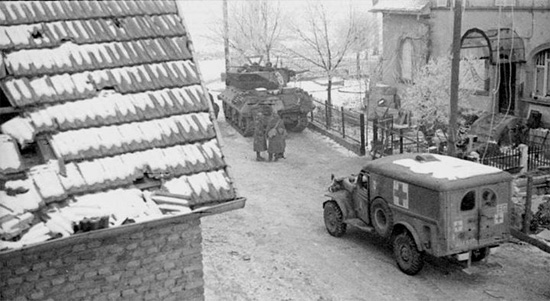
WC-54 3/4-ton Ambulance waiting to collect battle casualties in a little town in the Ardennes, Belgium. Photograph taken during the Battle of the Bulge.
Surgical Service
Lt. Colonel Fred W. T. Overton, MC, O-335209 > Chief Surgical Service, General Surgery
Major Heyward J. Blackmon, MC, O-271025 > Chief Eye, Ear, Nose, Throat Section, EENT Specialist
Major Walter H. Hagen, MC, O-305949 > Chief Orthopedic Section, Orthopedic Surgery
Major Joseph A. Novello, MC, O-294510 > Surgical Officer, General Surgery
Major Abraham M. Sands, MC, O-297764 > Surgical Officer, General Surgery
Captain Lee F. Cayce, MC, O-526592 > Officer EENT Section
Captain Joseph A. Chobian, MC, O-523846 > Surgical Officer, NP Surgery
Captain Eugene B. Glenn, MC, O-310948 > Surgical Officer, General Surgery
Captain John M. Kibler, MC, O-1683896 > Chief Urology Section
Captain Charles B. Moore, MC, O-532528 > Asst Chief Urology Section (transferred to 3d Station Hospital 26 Apr 44)
Captain Bruce I. Ryder, MC, O-511047 > Surgical Officer, General Surgery
1st Lieutenant Pleasant Collinsworth, MC, O-1684095 > Asst Chief Orthopedic Section
1st Lieutenant Russell C. Hanselman, MC, O-530947 > Surgical Officer, General Surgery
1st Lieutenant Jesse J. Michaelson, MC, O-1590629 > EENT Section, Ophthalmology Specialist
Medical Service
Major Jabez F. Jackson, MC, O-38402 > Chief Medical Service
Major Jefferson F. Klepfer, MC, O-528523 > Chief Psychiatry Section
Major Charles W. Knerler, MC, O-482061 > Chief Dermatology Section, Epidemiology Specialist
Major Emanuel J. Levin, MC, O-400512 > Medical Officer, Internal Medicine
Major David B. Snelling, MC, O-263294 > Cardiologist
Captain Aurelius J. Bambara, MC, O-356515 > Medical Officer, General Medicine
Captain Robert L. Berry, MC, O-356424 > Medical Officer, General Medicine
Captain Meyer Bloom, MC, O-530600 > Chief Dispensary & Outpatient Clinic, Internal Medicine
Captain Harold G. Higgins, MC, O-1683014 > Medical Officer, General Medicine
Captain Wilfred G. Hulse, MC, O-512783 > Asst Chief Psychiatry Section & Pediatrics Section
Captain William Jacobs, MC, O-364944 > Medical Officer, General Medicine, EENT Specialist
Captain Harold W. Muecke, MC, O-332376 > Medical Officer, Pediatrist
Captain Hunter B. Rogers, MC, O-246546 > Medical Officer, General Medicine
Captain John D. Sheehan, MC, O-466177 > Medical Officer, General Medicine
Captain Stanley E. Telser, MC, O-467566 > Medical Officer, Cardiologist
Captain Frank Valentine, MC, O-422004 > Medical Officer, Psychiatrist
1st Lieutenant Joseph Schafer, MC, O-532231 > Medical Officer, General Medicine
Laboratory Service
Major Austin Joyner, MC, O-1690526 > Chief Laboratory Service
Captain Armin C. Braun, SnC, O-521030 > Laboratory Officer, Bacteriologist
1st Lieutenant Abe A. Danish, SnC, O-530599 > Laboratory Officer, Biochemist
X-Ray Service
Major Benjamin Felson, MC, O-460234 > Chief Roentgenology Service
Dental Service
Major Carl E. Ellis, DC, O-211485 > Chief Dental Service
Captain Murray Bell, DC, O-1689427 > Dental Officer, Oral Surgery
Captain Lieutenant Milton Blain, DC, O-492055 > Dental Officer, Anesthetist
Captain Albert L. Blanket, DC, O-489763 > Dental Officer, Dental Surgeon
Captain Welton D. Pearson, DC, O-345376 > Dental Officer, Prosthetics & Surgery Officer

28th General Hospital, Fort de la Chartreuse, Liège, Belgium. Top left; front view of main medical building, top right; OR staff on roof of building,
bottom left; Medical and Surgical Technicians, bottom right; another view of OR personnel on the roof of the hospital building.
Quartermaster Service
1st Lieutenant George W. Coleman, QMC, O-1578287 > Quartermaster
2d Lieutenant John C. Estill, QMC, O-1578434 > Motor Officer
Chaplains
Captain Maurice J. McDonald, ChC, O-516185 > Catholic Chaplain
Captain Oscar R. Powell, ChC, O-476943 > Protestant Chaplain
Female Officers
Army Nurse Corps
Captain Margaret B. Miller, ANC, N-743010 > Principal Chief Nurse
1st Lieutenant Eva M. Reese, ANC, N-775910 > Asst Chief Nurse
—o—
1st Lieutenant Irene O. Ciminera, ANC, N-726272 > Head Nurse, Anesthetist
1st Lieutenant Mabel L. Johnson, ANC, N-775920 > Medical Supervisor
1st Lieutenant Rose M. Kuenzie, ANC, N-744664 > Chief Nurse, Operating Room Supervisor
1st Lieutenant Hilda M. Leible, ANC, N-732374 > Night Supervisor
1st Lieutenant Frances R McAllister, ANC, N-726302 > Surgical Supervisor
1st Lieutenant Evelyn G. Prescott, ANC, N-726705 > Operating Room Nurse
2d Lieutenant Elizabeth Artz, ANC, N-703926 > Anesthetist
2d Lieutenant Gladys L. Bigelow, ANC, N-763708 > Head Nurse, Medical Division I
2d Lieutenant Erma H. Binder, ANC, N-730644 > Ward Nurse, Surgical Service
2d Lieutenant Eloise E. Boatright, ANC, N-726955 > Ward Nurse, Medical Service
2d Lieutenant Elizabeth A. Bombach, ANC, N-725690 > Operating Room Nurse
2d Lieutenant Margaret A. Brennan, ANC, N-756539 > Ward Nurse, Medical Service
2d Lieutenant Clarice O. Bruso, ANC, N-756536 > Asst Head Nurse, Medical Division IV
2d Lieutenant Lucy W. Calloway, ANC, N-763841 > Charge of Quarters
2d Lieutenant M. Jeanne Campbell, ANC, N-755400 > Head Nurse, Medical Skin Division
2d Lieutenant Edna G. Carlisle, ANC, N-727840 > Anesthetist
2d Lieutenant Margaret A. Carpenter, ANC, N-755379 > Ward Nurse, Medical Service
2d Lieutenant Susan Chakan, ANC, N-755284 > Ward Nurse, Surgical Service
2d Lieutenant Mary L. Chestnut, ANC, N-763970 > Asst Head Nurse, Surgical Division IV
2d Lieutenant Annie Belle Cochran, ANC, N-763095 > Ward Nurse, Medical Service
2d Lieutenant Leafy C. Cochran, ANC, N-727540 > Ward Nurse, Medical Service
2d Lieutenant Martha L. Cocke, ANC, N-727385 > Ward Nurse, Medical Service
2d Lieutenant Frances L. Conrad, ANC, N-763898 > Ward Nurse, Medical Service
2d Lieutenant Beulah J. Cook, ANC, N-726911 > Ward Nurse, Medical Service
2d Lieutenant Camille Cookro, ANC, N-728338 > Ward Nurse, Surgical Service
2d Lieutenant Cecilia Curley, ANC, N-720475 > Ward Nurse, Surgical Service
2d Lieutenant Shirley H. Cutts, ANC, N-771870 > Ward Nurse, Surgical Service
2d Lieutenant Eleanor A. Dejno, ANC, N-730395 > Ward Nurse, Medical Service
2d Lieutenant Anna J. Dorsey, ANC, N-728192 > Head Nurse, Outpatient Department
2d Lieutenant Lolah A. Farabee, ANC, N-763908 > Head Nurse, Medical Division IV
2d Lieutenant Helen M. Farb, ANC, N-763745 > Operating Room Nurse
2d Lieutenant Helen L. Fisher, ANC, N-721805 > Ward Nurse, Surgical Service
2d Lieutenant Mary J. Fox, ANC, N-724775 > Asst Head Nurse, Junior & Senior Officer Division
2d Lieutenant Reva M. Fullmer, ANC, N-730818 > Asst Night Supervisor
2d Lieutenant Evelyn F. Goodrum, ANC, N-726705 > Head Nurse, Surgical Division I
2d Lieutenant Florence J. Green, ANC, N-771681 > Head Nurse, Surgical Division III
2d Lieutenant Mary C. Green, ANC, N-763634 > Ward Nurse, Medical Service
2d Lieutenant Bertha U. Grupp, ANC, N-773096 > Ward Nurse, Surgical Service
2d Lieutenant Betty T. Hafley, ANC, N-723238 > Ward Nurse, Medical Service
2d Lieutenant Miriam H. Hall, ANC, N-755216 > Ward Nurse, Surgical Service
2d Lieutenant Katherine A. Hammond, ANC, N-723837 > Ward Nurse, Surgical Service
2d Lieutenant Rachel M. Harrison, ANC, N-731312 > Asst Head Nurse, Medical Skin Division
2d Lieutenant Pauline Hill, ANC, N-726877 > Asst Head Nurse, Medical Division I
2d Lieutenant Arriel M. Hillesheim, ANC, N-730454 > Head Nurse, Medical Division III
2d Lieutenant Marian L. Hurley, ANC, N-783093 > Ward Nurse, Surgical Service
2d Lieutenant Celeste Jackson, ANC, N-726342 > Ward Nurse, Surgical Service
2d Lieutenant Ruth M. Jenkins, ANC, N-727856 > Ward Nurse, Surgical Service
2d Lieutenant Elizabeth K. Jensen, ANC, N-728873 > Head Nurse, Surgical Division IV
2d Lieutenant Jeannette F. Kneeland, ANC, N-721816 > Ward Nurse, Medical Service
2d Lieutenant Bertha K. Knigge, ANC, N-727661 > Ward Nurse, Medical Service
2d Lieutenant Muriel A. Kragh, ANC, N-763709 > Ward Nurse, Medical Service
2d Lieutenant Emily Lahendro, ANC, N-767099 > Ward Nurse, Medical Service
2d Lieutenant Aquinas Leehey, ANC, N-732380 > Ward Nurse, Medical Service
2d Lieutenant Judy Liles, ANC, N-727546 > Ward Nurse, Surgical Service
2d Lieutenant Claradel Linquist, ANC, N-732381 > Head Nurse, Surgical Division II
2d Lieutenant Helen Livingston, ANC, N-763291 > Ward Nurse, Surgical Service
2d Lieutenant Mary E. Lyon, ANC, N-756540 > Asst Head Nurse, Surgical Division II
2d Lieutenant Arlene Z. Madden, ANC, N-727898 > Ward Nurse, Surgical Service
2d Lieutenant Pauline Maguire, ANC, N-732382 > Asst Head Nurse, Surgical Division III
2d Lieutenant Eula R. Martin, ANC, N-737867 > Ward Nurse, Surgical Service
2d Lieutenant Mary E. Martin, ANC, N-727863 > Ward Nurse, Medical Service
2d Lieutenant Eleanor P. Mason, ANC, N-732370 > Ward Nurse, Surgical Service
2d Lieutenant Agnes A. McElhinney, ANC, N-723832 > Ward Nurse, Surgical Service
2d Lieutenant Opal N. Meier, ANC, N-729880 > Ward Nurse, Surgical Service
2d Lieutyenant Bernice Merrifield, ANC, N-772335 > Ward Nurse, Medical Service
2d Lieutenant Bertha A. Miller, ANC, N-724796 > Ward Nurse, Surgical Service
2d Lieutenant Willa V. Miller, ANC, N-763994 > Ward Nurse, Medical Service
2d Lieutenant Sarah Montgomery, ANC, N-726467 > Ward Nurse, Surgical Service
2d Lieutenant Gertrude Moore, ANC, N-727612 > Ward Nurse, Medical Service
2d Lieutenant Grace Moore, ANC, N-763271 > Ward Nurse, Surgical Service
2d Lieutenant Laura N. Mosley, ANC, N-726995 > Head Nurse, Junior & Senior Officer Division
2d Lieutenant Evah M. Nawman, ANC, N-728406 > Asst Head Nurse, Junior & Senior Officer Division
2d Lieutenant Sue Nelson, ANC, N-763435 > Ward Nurse, Surgical Service
2d Lieutenant Virginia K. Nichols, ANC, N-767100 > Ward Nurse, Medical Service
2d Lieutenant Bess L. Ogletree, ANC, N-763196 > Head Nurse, Medical Division II
2d Lieutenant Lora J. Pace, ANC, N-727395 > Operating Room Nurse
2d Lieutenant Elizabeth T. Paserb, ANC, N-755097 > Ward Nurse, Medical Service
2d Lieutenant Mary F. Patterson, ANC, N-727384 > Ward Nurse, Medical Service
2d Lieutenant Jeanella F. Price, ANC, N-727695 > Ward Nurse, Surgical Service
2d Lieutenant Frances M. Rosi, ANC, N-731367 > Asst Head Nurse, Surgical Division I
2d Lieutenant Maria V. Sagrilla, ANC, N-767103 > Ward Nurse, Medical Service
2d Lieutenant Glendora Sargent, ANC, N-751140 > Ward Nurse, Medical Service
2d Lieutenant Lucile Satterwhite, ANC, N-763173 > Ward Nurse, Surgical Service
2d Lieutenant Barbara E. Scott, ANC, N-751053 > Ward Nurse, Medical Service
2d Lieutenant Marjory B. Scruggs, ANC, N-763412 > Ward Nurse, Medical Service
2d Lieutenant Marjorie Seekins, ANC, N-720094 > Ward Nurse, Surgical Service
2d Lieutenant Frances M. Sheridan, ANC, N-723326 > Ward Nurse, Surgical Service
2d Lieutenant Geneviève Smola, ANC, N-721240 > Ward Nurse, Surgical Service
2d Lieutenant Sara Stoner, ANC, N-763359 > Ward Nurse, Surgical Service
2d Lieutenant Anne T. Stout, ANC, N-763782 > Asst Head Nurse, Outpatient Department
2d Lieutenant Chrystine L. Suitor, ANC, N-727788 > Ward Nurse, Medical Service
2d Lieutenant Zelda Sutton, ANC, N-726343 > Ward Nurse, Surgical Service
2d Lieutenant Grace L. Turner, ANC, N-755388 > Asst Head Nurse, Medical Division III
2d Lieutenant Elizabeth Wade, ANC, N-756571 > Ward Nurse, Medical Service
2d Lieutenant Margaret V. Wall, ANC, N-737825 > Ward Nurse, Surgical Service
2d Lieutenant Mildred E. Wardlaw, ANC, N-763172 > Ward Nurse, Surgical Service
2d Lieutenant Virginia Warren, ANC, N-727205 > Ward Nurse, Surgical Service
2d Lieutenant Maxine Watt, ANC, N-730924 > Ward Nurse, Medical Service
2d Lieutenant Vertrece Watwood, ANC, N-727789 > Ward Nurse, Medical Service
2d Lieutenant Helen O. Weissbeck, ANC, N-732384 > Asst Head Nurse, Medical Division II
2d Lieutenant Mary R. Wilkins, ANC, N-763704 > Ward Nurse, Surgical Service
2d Lieutenant Hazel Williamson, ANC, N-763532 > Ward Nurse, Medical Service
2d Lieutenant Neta B. Wilson, ANC, N-763488 > Ward Nurse, Surgical Service
2d Lieutenant Gwendolyn Yniestra, ANC, N-726046 > Ward Nurse, Surgical Service
+
Elizabeth L. Blum
Luda Boswell
Elizabeth S. Cadman
Elizabeth G. Cosner
Evelyn Couse
Helen A. Dunn
Bertha Ellington
Jean Fitzsimmons
Frances L. Lake
Claude F. Linn
Iris K. Littlefield
Fay A. Maxey
Ruth McWain
Elizabeth H. S. McWatt
Marie W. Nieman
Katherine Norwood
Ann I. Petraitus
Mary G. Quigley
Beatrice J. Sarrockie
Marion A. Stringer
Constantine S. Viola
Wilma Wait
Hansel H. Walden
Vera Woolfson

Winter view of destructions caused to the 28th General Hospital, Liège, after being hit by a V-1 buzz-bomb 9 January 1945.
Physio-Therapy Service
1st Lieutenant Elma L. Georg, PTA, M-544 > Physio-Therapist
2d Lieutenant Mary J. Wullenwaber, PTA, M-570 > Physio-Therapist
Hospital Dietitian Service
1st Lieutenant Elizabeth S. Goodman, HD, R-795 > Hospital Dietitian
1st Lieutenant Laviana L. LaForge, HD, R-812 > Hospital Dietitian
2d Lieutenant Nell L. Moore, HD, R-152 > Hospital Dietitian
Enlisted Men:
| Howard C. Aadland | Curtis W. Lee |
| José A. Acevedo | Troy Lee |
| Kames E. Acker | Aouinas Leehey |
| George W. Ackerman | John Lempka |
| William Adams | Vaine Leslie |
| Earl G. Aldrich | Wilfred P. Letendre |
| Vernon J. Alexander | Clifford W. Leuchtenmacher |
| James Alfieri | Wilford R. Libertoff |
| Harold C. Amerson | Leslie B. Lindstrom |
| Robert D. Ames | Wilbur H. Link |
| Robert L. Anderson | Leonard J. Little |
| Max Andler | Harold F. Long |
| Carl G. Andreesen | Eric Lorge |
| Angelo J. Aniello | Elbert L. Lovett |
| Alexander Antonewicz | Edward J. Lubinsky |
| Edwin B. Armstrong | Joseph J. Lucas |
| Charles R. Auger | Peter Lukas |
| Alvino August | Charles L. Mackay |
| William J. Auld | Frank W. Mancini |
| William O. Bailey | William H. Maness |
| James P. Baker | James H. Mangos |
| John S. Baker | John L. Manso |
| Armand B. Banin | Ray Manyard |
| Arthur J. Barrett | Thomas P. Martin |
| Paul Bartelt | Walter E. Martin |
| John F. W. Baun | Manuel Martinez |
| Roy C. Beamon | Edward R. Massengale |
| Galen C. Beard | H. Richard Mather |
| Leo J. Beauchemin | John R. Mathews |
| Seymour Beaver | Howard C. Matthews |
| Kenneth P. Bell | Lucien W. Mathieu |
| Edward J. Bencivenga | Thomas L. Mawn |
| Dan Bennett | Armand J. Maurice |
| William Berezik | Robert W. Mayhew |
| Robert F. Bingham | James McCord |
| Robert L. Birkey | Leathel E. McDaniel |
| Arthur J. Bishop | Joseph A. McDermott |
| Euel O. Bishop | John P. McDonald |
| Fred W. Blackmore | James D. McDonough |
| Bonnie E. Bland | Robert J. McNally |
| Dewey E. Blair | Ralph T. Meixsell |
| Joseph B. Blasioli | Anthony Membrine |
| John P. W. Blinn | William F. Menard, Jr. |
| Wesley Blough, Jr. | George B. Merlino |
| George J. Bobb | Millicent Mermell |
| Joseph F. Bogacki | Perley S. Merrill |
| Edward C. Bogden | John M. Metzak |
| Robert S. Booth | Victor F. Meyer |
| Nathan A. Bordeau | Maurice H. Meyers |
| Oscar Boyd, Jr. | Philip Micalizzi |
| Jack Brackins | George J. Miller |
| Richard M. Bradshaw, Jr. | Jacob D. Miller |
| Albert E. Brandt | Walter J. Mirocha |
| Lionel G. Brattland | George T. Mitchell |
| Hus C. Brender | Edmund Mocek |
| John N. Briggs | Albert P. Monaco |
| Prudencio Q. Briones | Lucien J. Morency |
| John W. Brock | Fred C. Morgan |
| Chester A. Brooks | George W. Morgan |
| Edwin M. Brown | John T. Morrison, Jr. |
| Hubert H. Brown | Floyd D. Mowery |
| John Brown |
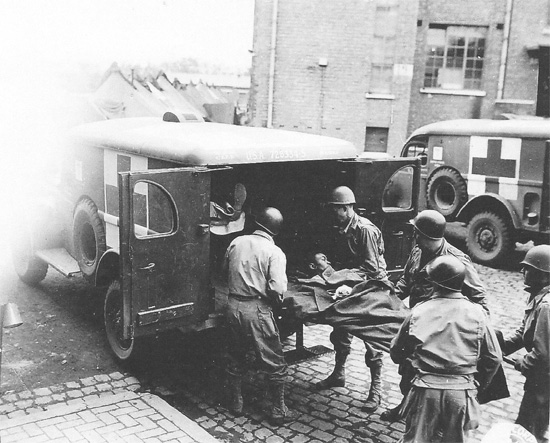
Bringing in patients by WC-54 3/4-ton Ambulance at the 28th General Hospital, Liège, Belgium. Photo probably taken in spring of 1945.
| Samuel B. Brown, Jr. | Paul U. Mozzi |
| William N. Brown | William L. Murray |
| Walter J. Bruce | Eddie Myles |
| Donald M. Budzenski | Alden A. Nageotte |
| Francis X. Bumpus | Richard E. Nantelle |
| Wilfred G. Bussiere | Anthony Nargi |
| Esbon D. Butler | Eval Nawman |
| James H. Butler | Truman A. Neff |
| Edward T. Byrne | Edward Niedziela |
| Albert A. Call | Murray Norins |
| John Camara | Andrew R. Novak |
| Joseph Campagna | Raymond L. Nowve |
| Owen C. Campbell | Richard J. O’Donnell |
| Joseph D. Cannon | Leslie W. Ofner |
| Angelo F. Casalini | Merle W. Ogle |
| Luther J. Cassidi | Charles B. Oglesby |
| Clifford C. Cave | John A. Oliver |
| Victor Ceterski | Michael Olson |
| Harold L. Chambers | Henry F. Osinski |
| William S. Chapman | Martin H. O’Toole, Jr. |
| George W. Cheaves, Jr. | Louis E. Owens |
| John E. Checlo | Norbert F. Pagel |
| Benjamin C. Chernoski | Benjamin Parrovechio |
| Warren S. Churchill | George L. Pasqua |
| Stephen B. Chytillo | John Pastick |
| Francis J. Clancy | Thomas L. Patterson, Jr. |
| John J. Clary | John D. Payne |
| Everett E. Clodwell | Siegfried Peilte |
| Joseph L. Coates | Charles Perdue |
| Agostino J. Cocozza | Francis D. Perella |
| Harold Cohen | John A. Perich |
| Robert Cohen | Stanley J. Perkowski |
| Samuel Cohen | Frank O. Peterson |
| Joseph A. Conlon | James F. Peterson |
| Robert H. Conroy | James Petraitis |
| Joseph N. Contaldo | Nicholas Pino |
| John A. Cook | Rudolph Pirhala |
| Amos Coppi | Donald L. Pirtle |
| Morton Cordish | Willam M. Pitt |
| James J. Coronito | Erwin C. Ploer |
| Earl C. Costa | George H. Pogorzelski |
| Manuel F. Costa | Arthur Pomeroy |
| Render E. Cox | Michael F. Poncsak, Jr. |
| Stanley H. Crabtree | Alex M. Ponichtera |
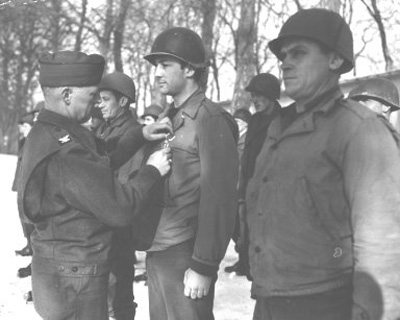
Typical view of an official “Purple Heart” award ceremony. In general the medals would be presented to each individual patient (or ex-patient) by the CO of the medical unit where he was treated. Bedridden cases would receive the award in the wards where they were confined. Sometimes, a visiting General Officer was often invited to pronounce a few words and present the awards to add some luster to the ceremony.
| Glen S. Cramblit | John W. Popek |
| William B. Crane | Hoyle H. Presley |
| Michel J. Cronin | Posey E. Pullig |
| Fred W. Crossen | James Quinn |
| Rdgar H. Cunningham | Rudolph E. Rabatin, Jr. |
| James Cusumano | Bonner F. Rabb |
| James E. Dalton | James W. Ray |
| Joseph F. Dalton | Frank J. Redtke |
| William C. DaPrato | Everre C. Reed |
| Angelo A. Dardugno | Rudolph K. Regen |
| E. Colwyn Davies | Thomas Regna |
| Dewey C. Davis | Henty A. Reith |
| George Davis, Jr. | Earl C. Rellis |
| Royce C. Davis | Sam H. Renfroe |
| Cornelius J. DeBoer | Peter E. Reno |
| Clarence F. Decker | Lee F. Repka |
| Sidney Deese | Hyman Ressler |
| Peter P. DeFeis, Jr. | Donald L. Reynolds |
| Lawrence W. Delaney | Ross Reynolds |
| Joseph D. Delgado | George T. Rezak |
| Horace C. DeLoye | Paul J. Rich |
| Armand D. Demuth | John W. Richard |
| Sylvester W. Deni | Clarence H. Richardson |
| Thomas F. Desjardins | Morris Robinowich |
| William M. Desmond | James J. Roche |
| Lloyd Deugaw | Mauel Roger, Jr. |
| Charles Dickinson | Charles R. Rogers |
| Robert H. Dienberg | Paul Romanow |
| Victor J. DiGeronimo | Olen H. Rose |
| Ralph J. DiGiacomo | Reuben Rosen |
| Joseph R. DiMatteo | Sidney Rosenberg |
| Archie A. DiNucci | Harry M. Rubinove |
| Paul R. DiSalvo | Samuel D. Runyoh |
| Ralph H. Doerk | Marshall T. Ryan |
| Robert H. Doerk | Stanley J. Ryba |
| Anthony S. Dombrowski | Bruce I. Ryder |
| James E. Donahue | Kenneth C. Sack |
| Charles Doss | Willard J. Sager |
| Walter O. Dow | Andrew P. Salanski |
| John F. Drella | Wayne L. Sams |
| Michael J. Driscoll | Daniel L. Sander |
| Percy P. Dufrene | Curtis L. Sanders |
| Robert D. Dulac | Howard E. Sanders |
| James L. Duncan | Emil L. Santagelo |
| John O. Duncan | Thomas Sapanaro |
| John R. Dunster | Emilio D. Sapiago |
| Ed R. Durno | Joseph F. Saubel |
| Ezra Dyer | Ahrend F. Saul |
| John H. Dyer | Vertrees W. Sawyer |
| William A. Eastwood | Roy L. Scagel |
| William L. Eaton | John Schairer |
| John D. Eckert | Clarence L. Schall, Jr. |
| Zanly C. Edelson | Amos Schmidt |
| Charles H. Elliott | Bruno G. Scrizzi |
| Edmund J. Ellis | Herman W. Schultz |
| Jean L. Emery | Nathan Schwartz |
| John Estelle | Robert Sebern |
| Raymond N. Evans | Joseph P. Securro |
| Alex Evantoff | Joseph W. Serio |
| John W. Ewell | Frank J. Servidio |
| Robert L. Farmer | William H. Shearer |
| James F. Farrell | Rumsey L. Shenk |
| John F. Farrell | Stephen E. Sherry |
| Leonard Farris | Joseph S. Shocker |
| Joseph U. Faubert | Wiliam Shostrom |
| Miner F. Felch | Ralph G. Sidler |
| Lewis L. Ferrari | Charles A. Sikorski |
| Joseph Ferreris | Hauley R. Singleton |
| Roland C. Fields | Arnold Skelton |
| Robert D. Fife | Mischa Slatkin |
| Joseph A. Filardo | Charles L. Smith |
| John M. Fiore | Fred C. Smith |
| Clarence J. Fischer | Frederick A. Smith |
| William T. Fischer | James O. Smith |
| Thomas Flieger | Joseph M. Smith |
| J. D. Flowers | Raymond E. Smith |
| Wayne D. Foster | Robert W. Smith |
| Billy Foltner | William B. Smith |
| Robert Fous | Matthew Smolek |
| Karl Frank | Theodore E. Snell |
| John V. Franz | Thomas J. Snoderly |
| William B. Fratus, Jr. | Andrew M. Socha |
| Horace W. Free | William F. Spence |
| Jesse E. Free | Ariel M. Spencer |
| John D. Freeland | Leo Springer |
| Peter P. Fulara | Hugh A. Stakes |
| John F. Fuller | Sanford W. Stalvey |
| Henry Gabbard | George W. Stanley |
| Valentine J. Gasior | Marvin C. Stanley |
| Bert Gaskins, Jr. | Lawton W. Stanley |
| Geral D. Gee | Richard E. Stear |
| Albert O. W. Geier | Arthur Stein |
| Curtis D. George | Kenneth H. Stephens |
| John R. Gerlach | Luther C. Sterne |
| Richard R. Gherardi | Albert S. Stewart |
| Ray W. Gilbert | Warren A. Stoddard |
| Hyt O. Giles | William J. F. Stolting |
| Henry E. Golding | David W. Stone, III |
| Carl R. Good | Aslin Strahan |
| Leonard Goodman | Eulus C. Stratton |
| Joseph R. Goossens | Ira B. Stringer |
| Anton S. Grabowski | Herbert S. St.Romain, Jr. |
| Arenzell W. Graham | Emil M. Stuchal |
| Andrew J. Grainger | Edward Suarez |
| Sebastian A. Grasso | Samuel C. Sugg |
| Warren P. Gray | Martin Sullaway |
| Howard L. Green, Jr. | Gerald C. Sullivan |
| James H. Green | Vincent P. Sullivan |
| Paul P. Green | William R. Super |
| Benjamin F. Griffin | Wencil Susanka |
| Francis J. Griffin | John J. Sweeney |
| Roman Griva | Ernest B. Swett, Tec 4, 31175968 |
| William N. Gross | Mitchell S. Szady |
| Clifford W. Gurganus | Joseph E. Szozda |
| Cecil W. Hadaway | Stanley Szpejnowski |
| James E. Hadney | Anthony J. Taglieri |
| John E. Hagans, Jr. | Harry P. Tappscott |
| Richard E. Hahn | Charles T. Tatham |
| Aloha M. Hall | Louis J. Tatro |
| William L. Hall | Chester S. Taylor |
| Frank J. Hancock | Clifford E. Taylor |
| Willis K. Hancock | Randall M. Thomas |
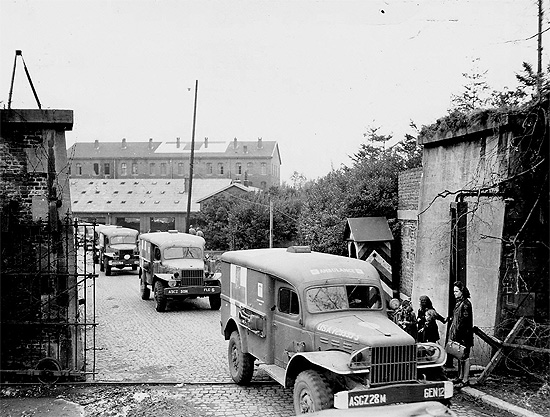
Convoy of WC-54 Ambulances leaving the 28th General Hospital installations, Liège, Belgium, fall of 1944.
| Richard W. Hanke | David S. Thompson, Jr. |
| Peter Haralam | Roy G. Thompson |
| Joseph J. Harrington | Edward G. Thorpe |
| Benjamin J. Harris | Joel R. Tilley |
| William R. Harris | Andrew P. Tipton |
| Lloyd H. Harshbarger | John Tocco |
| Nelson J. Heckman | Paul E. Tousignant |
| Walter W. Helms | Albert C. Townsend |
| John T. Henderson | Leo P. Toye |
| Charles W. Henkel | Albert L. Trammell |
| Emil S. Hennemann | Harry E. Travis |
| Ralph W. Henry | Harry B. Trimble |
| Edward V. Herlihy | Thomas F. Trivette |
| Donovan Hester | Roger Trudeau |
| Lloyd J. Hilligoss | Abe H. Tucker |
| Gamesindo Hinojosa | Roland B. Turner |
| Hughie Hiskins | Roscoe Turner |
| John T. Hilton | Daniel J. Twesten |
| Morris Hirschstein | Samuel Udkow |
| James J. Holden | Carl E. Uhrig |
| Edwin A. Holdren | Joseph A. Ulatowski |
| George W. Holleman | George Ulbrich |
| Charles C. Hollar | Ernest H. Ullery |
| James B. Holmes | Charles C. Underwood |
| Nelson E. Holt | Albert L. Vallillo |
| William A. Horelick | Joseph V. Valois |
| Walter J. Houtz | Anthony J. Vatlaro |
| Willie H. Howell | Harry L. Vaughan |
| Carlos Hulsey | Alphonse J. Vermote |
| John L. Humm | John Versteeg |
| Walter H. Hunt | Frank E. Vest |
| Kenneth L. Hussey | Lamar A. Vigne |
| William B. Hutchins | George E. Villeneuve |
| Thomas J. Ilfinger | Ernest J. Vozzella |
| George P. Ingram | Angelo Vranos |
| Harry Jasper | Max O. Waack |
| Hal E. Jehes | Charlie K. Walker |
| Richard C. Johnson | Charles T. Walls |
| Elvis E. Jones | Charles L. Walton |
| Lee R. Jones | Edward B. Warner |
| Karlo Kalvaitis | Stanley M. Wasung |
| Stanley Kaminski | Lawrence L. Waudby |
| Seymour Kaplan | Charles Wawrzynowicz |
| Edwin K. Kardokus | Norman Wax |
| Frank E. Kehaley | Walter E. Weis |
| John W. Kelley | Johnnie E. Welchel |
| Michael J. Kelly | Paul M. Whalen |
| Thomas J. Kelly | Thomas F. Whalen |
| Robert E. Kentor | Leon A. Wheeler |
| Robert W. Kershaw | John J. Wieczorek |
| Henry M. Kirk, Jr. | John A. Willard |
| Anthony P. Kirstein | Edwin Willbarger |
| John Kluchnick | Floyd F. Williams |
| Walter J. Kolodziej | Opel D. Williams |
| Thomas Koszowski | Robert L. Williams |
| Karl C. Koubal | Virgil G. Williams |
| James M. Koury | John C. Wilmes |
| Walter S. Kozak | Hugh Wilson, Jr. |
| Louis F. Kozikuski | Robert R. Wilson |
| Henry T. Krupinski | Ismael Wimer |
| Lawrence G. Laderoot | Frank J. Wisniewski |
| Stephen E. Laffin | Cleve Wolford |
| Evariste T. LaFlamme | Fred C. Wright |
| Wilfred A. LaMarche | Robert J. Wuenstel |
| Leo P. Lamoureux | Alexander J. Worzelman |
| Harry V. Lanagan | Arthur F. Wren |
| Robert P. Lane, Jr. | Robert J. Wuenstel |
| Orvel M. Langston | William T. Wynne |
| George L. La Plant | Donald C. Young |
| Donald I. Larson | Eugene A. Young |
| Robert E. Latta | Frank U. Young |
| Allen Laughlin | Sam Zarkin |
| Joseph E. Lausier | John Zelak |
| Michael Lavorgna | Michael Zeliznak |
| William L. Lawing, Jr. | Frederick W. Ziegler |
| James L. Laws | Robert L. Zimmerman |
| John D. Lawton |
note: four (4) Enlisted Men were killed in a train accident. They were:
William H. Coble (Oklahoma)
James J. Curran (Massachusetts)
John C. McDonald (Massachusetts)
Francis Walkden (Massachusetts)
Campaign Credits – 28th General Hospital
Northern France (miniature bronze service star awarded 16 Feb 45)
Rhineland (miniature bronze star awarded 26 Feb 45)
Ardennes-Alsace (miniature bronze service star awarded 18 Jun 45)

Souvenir plaque dedicated to the 28th General Hospital adorning one of the walls of the derelict buildings of the Fort de la Chartreuse, Liège, Belgium, which housed the hospital unit from 26 September 1944 through 5 July 1945.
We are particularly grateful to the late Lynn F. McNulty, son of World War Two Veteran Captain Frederick J. McNulty, who provided us with some basic reports relating to subject Hospital. We further wish to thank Barry Gross, son of Staff Sergeant William N. Gross, and Walter Swett, son of Technician 4th Grade Ernest B. Swett (ASN:31175968) who kindly offered a number of documents and illustrations concerning the 28th General Hospital, in which both their Fathers served in World War Two. Special thanks are also due to Charles W. Rush, son-in-law of Lieutenant Colonel Walter H. Gerwig, Jr. (O-334762) Executive Officer, 28th General Hospital, who generously shared Dr. Gerwig’s War Diary including a number of vintage photos. Thank you so much for your precious assistance. We also received some very interesting additional data from Christine Viscomi, daughter of First Lieutenant Theodore Monolidis (ASN:O-2046759) Assistant Registrar, 28th General Hospital, relating to the Battle of the Bulge, December 1944. Still looking for information covering the unit’s last operations in USFET, and its return to the Zone of Interior.
